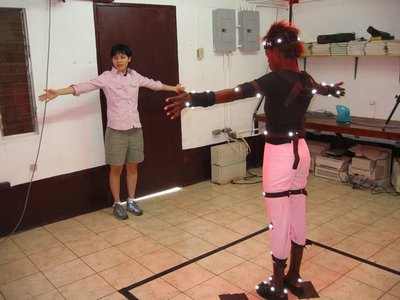January 12, 2006
Symmetry and skill: Dancing quality matches mate quality, study shows
Polyester aside, the disco dancers of the ’70s may have been on to something.
According to a new study that used motion-capture technology to analyze and accurately recreate the moves of dancing Jamaican teens, people appear able to pick genetically superior partners based on the way they dance.
The research, done jointly by computer scientists at the UW and anthropologists at Rutgers University, represents the first time scientists have been able to link skillful dancing to established measures of human desirability and attractiveness.
The work appears as the cover story in Thursday’s issue of the journal Nature.
“This suggests a completely new way in which dance will be looked at and analyzed in the future,” said Zoran Popović, associate professor in the UW Department of Computer Science & Engineering and a co-author of the study. “It’s the first time it has been shown that people can discern genetic quality from dance and movement itself.”
The project also opens a new chapter in the use of motion-capture technology and computer animation, Popović’s primary fields of study. The techniques have been used in rehabilitative and sports medicine and, more familiarly, in creating feature movie animations and special effects.
“But use of motion capture as a tool for analysis and archiving of movement in indigenous cultures has not been attempted — this is the first time it’s really been taken into the field and used as an anthropology tool,” he said. “So there is excitement not only in terms of scientific discovery, but also in terms of having a new scientific tool that can answer many questions pertaining to human movement and its role in human evolution and society.”
In conducting the study, researchers traveled to Southfield, Jamaica, where dance is culturally important to both sexes. That area also has a group of youths whose development has been tracked for body symmetry over the past decade. Evolutionary biologists have established close links between symmetry and such traits as longevity, strength and reproductive success in many animal species, including humans.
The researchers analyzed 183 members of that group, age 14 through 19, attaching infrared markers to the teenagers at 41 body locations. They filmed each teen for one minute, dancing to the same popular song, with special cameras that tracked the markers to record in detail how the dancers moved.
Popović and his colleagues processed that raw data to create dancing animations that duplicated the movements of the dancers. They then asked teen peers to evaluate how well the computer-generated figures danced. The figures were the same size, faceless and gender-neutral so evaluators had to base their answers on movement rather than other considerations, such as physical attractiveness.
The study showed that the dancers who rated best tended to be those with greater body symmetry. And symmetry is correlated with better genes, Popović said.
`”At least since Darwin, scientists have suspected that dance so often plays a role in courtship because dance quality tracks with mate quality,” said Lee Cronk, associate professor of anthropology at Rutgers and project leader. “By using motion-capture technology, we can confidently peg dancing ability to desirability.”
Scientists also broke down the results by gender. They found that symmetrical men scored better than symmetrical women, and that female evaluators rated symmetrical men higher than male evaluators rated symmetrical men.
That’s not surprising, according to William Brown, Rutgers postdoctoral research fellow and a study co-author.
“In species where fathers invest less than mothers in their offspring, females tend to be more selective in mate choice and males therefore invest more in courtship display,” Brown said. “Our results with human subjects correlate with that expectation. Attractive men are putting on a better show, and women are noticing.”
In addition to Popović, Cronk and Brown, co-authors of the study include graduate student Keith Grochow and recent doctoral graduate Karen Liu, of the UW; and professor Robert Trivers and graduate student Amy Jacobson of Rutgers.
The work was supported by Rutgers and the UW, the Ann and Gordon Getty Foundation, the Biosocial Research Foundation and the National Science Foundation.



